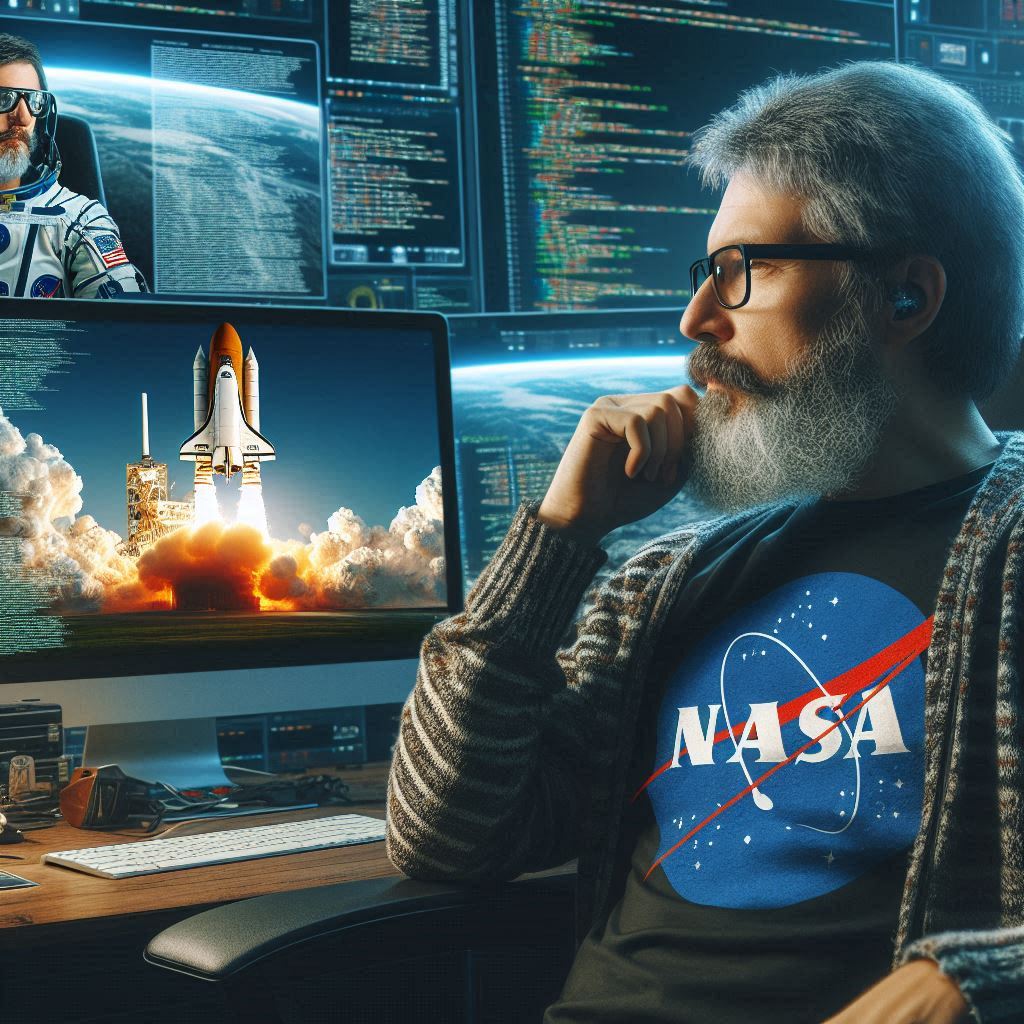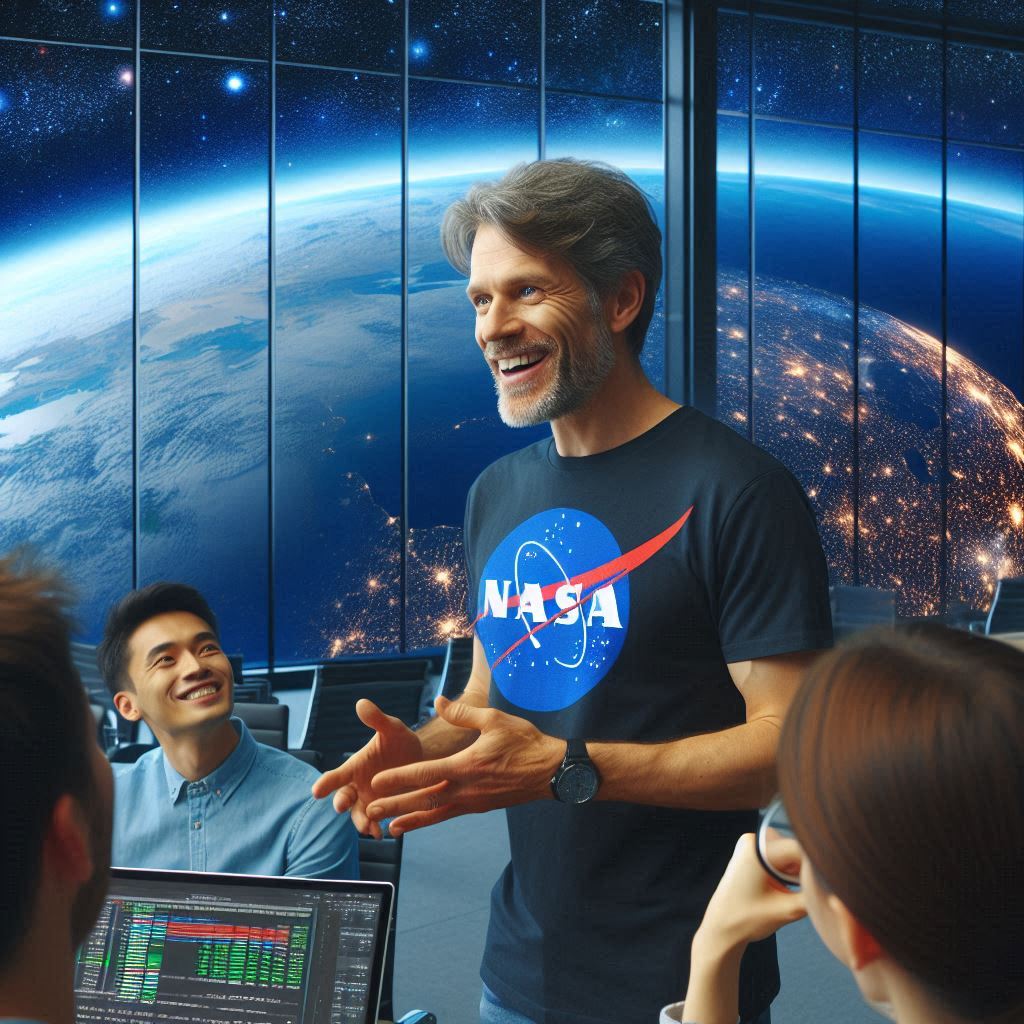Introduction
Let’s explore the role of software in space exploration historical breakthroughs
Overview of space exploration and its significance
Space exploration represents humanity’s relentless quest for knowledge beyond Earth.
From the launch of Sputnik to the Apollo moon landings, each mission has pushed boundaries.
These endeavors have significantly enhanced our understanding of the universe and our place within it.
Importance of software in advancing space missions
Software plays a crucial role in advancing space missions.
It serves as the backbone for spacecraft operation, navigation, and data analysis.
Without software, even the most sophisticated spacecraft would struggle to function effectively.
Engineers and scientists rely on software to achieve complex calculations and ensure safety during missions.
Purpose of the blog post: to explore historical breakthroughs in software used in space exploration
This blog post aims to explore historical breakthroughs in software used in space exploration.
By examining pivotal moments, we can appreciate how software has transformed the way we explore outer space.
Historical Breakthroughs in Software
One of the earliest breakthroughs in space software occurred during the Apollo program.
The Apollo Guidance Computer (AGC) was revolutionary, integrating hardware and software into a compact system.
Its software helped astronauts navigate to the Moon with precision.
This remarkable feat showcased the potential of software in real-time decision-making under extreme conditions.
As technology evolved, so did space software.
The development of the Space Shuttle Program introduced new software systems for mission control and onboard management.
These systems enabled better communication between ground control and astronauts, enhancing mission safety.
In recent years, software advancements have further elevated space exploration.
Robotics, driven by sophisticated software, have explored distant celestial bodies.
For instance, software-driven rovers like Curiosity and Perseverance have gathered vital data on Mars.
They operate autonomously, conducting experiments and sending critical information back to Earth.
Additions like artificial intelligence (AI) are reshaping how we explore space.
AI tools analyze vast amounts of data efficiently, uncovering patterns that humans might overlook.
This capability drives new discoveries and enhances our understanding of the cosmos.
In summary, software has become indispensable in space exploration.
Its historical breakthroughs have reshaped missions and expanded our knowledge.
As we look to the future, we can expect even greater innovations driven by software in our quest to explore the unknown.
Early Space Exploration and Computing
Overview of the technological landscape during the early space race
The early space race marked a pivotal moment in technological advancements.
During this period, the competition between the United States and the Soviet Union ignited remarkable innovations in various fields.
Countries focused heavily on aerospace, computer science, and engineering.
The Cold War backdrop played a crucial role in accelerating technology development.
The landscape consisted of several key components:
- Rocket Technology: Engineers developed powerful rockets capable of reaching space.
- Telecommunications: Communication systems improved to handle data transmission from space.
- Materials Science: New materials created stronger spacecraft that could withstand extreme conditions.
- Aerodynamics: Scientists conducted extensive research to optimize vehicle designs for flight through the atmosphere.
- Computational Resources: Available computing power was limited, but innovations were underway.
Each component contributed to the ambitious goals of exploring beyond Earth.
The intense rivalry fueled a race for groundbreaking discoveries.
Both countries recognized the essential role software would play.
Put Your Tech Company on the Map!
Get featured on Nicholas Idoko’s Blog for just $50. Showcase your business, boost credibility, and reach a growing audience eager for tech solutions.
Publish NowIntroduction to the early computational tools and software
Computers during the early space exploration were rudimentary compared to today’s machines.
Despite their limitations, they laid the groundwork for future advancements.
Early computational tools were primarily analog devices.
Nevertheless, innovators created software specifically for navigating and controlling spacecraft.
Key features of these early tools included:
- Data Processing: Engineers used software for analyzing complex flight data.
- Navigation Systems: Software algorithms helped pilots determine trajectories.
- Control Systems: Specialized programs allowed for automated navigation and operations.
- Simulation Tools: Developers created simulators to train astronauts and refine spacecraft designs.
Software often ran on vacuum tube systems or early transistors.
Programmers wrote simple codes, usually in machine language, making the processes complex.
Despite these hurdles, they achieved impressive results.
An essential part of this evolving landscape involved collaboration among various teams.
Scientists, engineers, and computer specialists worked closely.
This synergy made possible advancements that many thought were unattainable.
Key missions that relied on software (e.g., Sputnik, Mercury)
Several groundbreaking missions illustrate the crucial role of software in early space exploration.
These missions set the tone for future endeavors and showcased the power of innovative computing.
- Sputnik 1 (1957): The Soviet Union launched the first artificial satellite. Software controlled its radio signals and orbit adjustments, allowing it to send valuable data back to Earth.
- Vostok 1 (1961): The first human spaceflight by Yuri Gagarin depended on on-board software for navigation and life support systems.
The success of this mission marked a significant achievement in space history. - Project Mercury (1958-1963): This U.S. mission aimed to put humans in orbit. Engineers developed guidance software for precise launches and safe landings.
Programs ran complex calculations for each flight. - Mariner 2 (1962): This mission to Venus relied on sophisticated programming for navigation and communication. It became the first spacecraft to successfully perform a flyby of another planet.
- Apollo 1 (1967): Although tragic, this mission highlighted software testing’s significance. The fire revealed flaws in procedures, prompting changes that later made Apollo missions successful.
These missions paved the way for advancements that followed.
Engineers and scientists harnessed the early software to explore uncharted territories.
They collected data crucial for understanding our solar system.
Therefore, early space exploration marked a remarkable evolution in technology and computing.
The technological landscape spurred innovations that fundamentally changed how humanity approached space.
As engineers developed software, they pushed boundaries, allowing for groundbreaking missions that contributed to the vast knowledge of space.
These efforts laid the foundation for future explorations, creating a legacy that continues to drive innovation today.
Read: How Mainframes Revolutionized Software Development: A Retrospective
The Apollo Program: A Turning Point
Introduction to the Apollo missions and their objectives
The Apollo program marked a pivotal moment in human space exploration.
NASA initiated this ambitious project in 1961.
The main goal was to land humans on the Moon and bring them safely back to Earth.
The program laid the groundwork for future space exploration endeavors.
The Apollo missions comprised a series of missions between 1961 and 1972.
These missions not only aimed for lunar exploration but also expanded our understanding of space travel.
The objectives included:
- Developing technology to enable lunar landing and return.
- Conducting scientific experiments on the lunar surface.
- Testing human endurance for long-duration spaceflight.
- Gathering data for future exploration of Mars and beyond.
Ultimately, the Apollo program accomplished its mission spectacularly.
It led to six successful Moon landings.
Each mission contributed invaluable data to science and engineering.
The development of the Apollo Guidance Computer (AGC)
One of the most significant advancements during the Apollo era was the Apollo Guidance Computer (AGC).
The AGC was developed byMIT Instrumentation Laboratory in the late 1960s.
This computer was revolutionary for its time.
The AGC was compact, lightweight, and powerful, tailored specifically for space missions.
Put Your Tech Company on the Map!
Get featured on Nicholas Idoko’s Blog for just $50. Showcase your business, boost credibility, and reach a growing audience eager for tech solutions.
Publish NowIt weighed only 70 pounds and used integrated circuits for processing.
This innovation represented a major shift from vacuum tube technology.
Programmers coded the AGC in a language called AGC assembly language.
They optimized the software for real-time performance, which was crucial under mission pressures.
The development team faced various challenges:
- Limited memory space necessitated efficient programming.
- Real-time processing required strict timing precision.
- Reliability was paramount to ensure astronaut safety.
The AGC debuted on Apollo 11, the historic Moon landing mission.
The AGC provided critical calculations for navigation and landing, making the mission possible.
Role of software in navigation, control, and communication during lunar missions
Software played an essential role throughout the entire Apollo program.
It facilitated navigation, control, and communication during each lunar mission.
Navigation
The AGC operated as the spacecraft’s primary navigator.
It calculated trajectories for launch, lunar orbit insertion, and landing.
The software processed data from various sources, including:
- Star trackers to determine the spacecraft’s position.
- IMU (Inertial Measurement Unit) data to assess movement and velocity.
- Data from ground control to refine positions during flight.
Using this data, the AGC calculated necessary trajectory adjustments.
It made real-time decisions, allowing for dynamic course corrections.
Control
Control systems also depended heavily on software.
The AGC managed propulsion and landing systems.
It communicated directly with the spacecraft’s engines to ensure optimal performance.
For example:
- The software controlled the Lunar Module (LM) descent engine.
- It adjusted thrust levels based on altitude and velocity data.
- It ensured smooth landing on the lunar surface.
During Apollo 11, the AGC guided Neil Armstrong and Buzz Aldrin safely to the Moon.
They faced challenges during the landing, but the AGC adapted.
It allowed the astronauts to focus on the complex task of landing rather than manual calculations.
Communication
Software also enabled effective communication between astronauts and mission control.
The AGC processed commands from ground control.
It facilitated data transmission back to Earth, which included telemetry and scientific results.
Communication was more than just relaying messages.
It involved data integrity and error-checking mechanisms.
The AGC ensured that information remained accurate and secure.
During the missions, software updates were essential.
Engineers at MIT worked tirelessly to address any software issues that arose.
They enhanced the AGC’s performance as the missions progressed.
In summary, the Apollo program set new benchmarks in space exploration.
Software was the backbone of every critical operation.
It dictated navigation protocols, controlled spacecraft systems, and ensured robust communication.
The successful Moon landings not only demonstrated the power of software but also made space exploration accessible.
The innovations from the Apollo era influenced future space missions and technologies.
Put Your Tech Company on the Map!
Get featured on Nicholas Idoko’s Blog for just $50. Showcase your business, boost credibility, and reach a growing audience eager for tech solutions.
Publish NowToday, we continue to build on the foundation established by the Apollo program, leading humanity toward even greater horizons in our quest to explore the cosmos.
Read: The Untold Story of Early Software Failures and Their Impact
Space Shuttle Program: Integrating Complex Systems
The Space Shuttle program marked a transformative period in space exploration.
From 1981 to 2011, NASA’s fleet of orbiters served diverse scientific, military, and commercial purposes.
The ability to launch, retrieve, and repair satellites dramatically changed humanity’s capabilities in space.
Software played a crucial role in these operational feats.
Let’s explore the integrated software systems that powered the Space Shuttle program.
Overview of the Space Shuttle’s Operational Capabilities
The Space Shuttle combined several functionalities that were previously unavailable in one vehicle.
Its operational capabilities enabled a variety of missions:
- Satellite Deployment: The Shuttle placed numerous satellites into orbit, enhancing communication and weather forecasting.
- International Collaboration: The Shuttle facilitated partnerships with international space agencies, including ESA and Roscosmos.
- Space Station Construction: The Shuttle played a vital role in constructing the International Space Station (ISS).
- Crewed Missions: The Shuttle carried astronauts to various destinations, significantly advancing human spaceflight.
- Scientific Research: Dedicated missions allowed researchers to conduct experiments in microgravity, yielding groundbreaking discoveries.
This versatility was a direct result of sophisticated software systems controlling every aspect of the Shuttle’s operation.
Development of the Flight Software and Its Architecture
The development of the Space Shuttle’s flight software spanned years and involved multiple phases.
Teams of engineers and software developers collaborated to create a robust system.
The key features of the software architecture included:
- Modular Design: The software was organized into modules, allowing specific functionalities to be developed and tested independently.
- Real-Time Processing: The software had to process real-time data and respond instantly to any changes in flight conditions.
- Redundancy Systems: To ensure reliability, redundant systems were built in case of software or hardware failures.
- In-Flight Upgrade Capability: The Shuttle could receive software updates during missions, enhancing functionality and addressing issues.
- User-Friendly Interfaces: The cockpit included intuitive controls and displays, allowing astronauts to interact effectively with the software.
Each iteration of the software focused on improving integration across subsystems such as navigation, propulsion, and life support.
This complexity required rigorous development processes, including:
- Requirements Definition: Engineers gathered detailed user requirements to guide software development.
- Simulations: Extensive simulations tested the software’s performance under a variety of conditions.
- Code Reviews: Peer reviews ensured code quality and reliability, minimizing the risk of defects.
Through these processes, engineers developed a sophisticated software suite that managed the Shuttle’s myriad operational demands.
Importance of Software Testing and Reliability in Human Spaceflight
Testing software for the Space Shuttle was a rigorous and essential element.
As the software directly affected human lives, reliability was paramount.
The testing process included several critical steps:
- Unit Testing: Each software module underwent thorough unit testing to verify its individual functionality.
- Integrated Testing: After unit testing, engineers conducted integrated testing to confirm that modules worked together seamlessly.
- Hardware-in-the-Loop Testing: This technique simulated real operational environments, allowing for accurate assessments of performance.
- Flight Readiness Reviews: These comprehensive evaluations ensured all components, including software, were mission-ready.
Failures in software could have catastrophic consequences during a mission.
As a result, NASA established strict reliability criteria. The software had to demonstrate:
- Fault Tolerance: The ability to continue operation despite certain failures was a significant focus.
- Emergency Protocols: Systems designed to handle emergencies were a crucial part of flight software.
- Redundant Checks: Duplicate systems ensured that backup protocols operated effectively.
Moreover, the significance of software testing extended beyond the Shuttle.
Lessons learned influenced future space programs.
Continuous improvements in testing methodologies have resulted in safer, more reliable software for new spacecraft.
In fact, the Space Shuttle program showcased the critical role of software in space exploration.
Its operational capabilities demonstrated the potential of integrated systems.
Development and rigorous testing ensured that the Shuttle achieved its missions safely and effectively.
As we advance into the next era of space exploration, the foundations laid by the Shuttle program will guide future software solutions.
Understanding its history equips us to face the challenges of exploring beyond our planet.
Read: The Influence of Cloud Computing on Software History: A Guide for IT Managers

Advancements in Robotics and Automation
Introduction to Robotic Missions and Their Increasing Complexity
In the realm of space exploration, robotics plays a pivotal role.
Robotic missions have evolved significantly since their inception.
Early missions relied on basic instructions and minimal automation.
As technology advanced, so did the capabilities of robotic systems.
Modern missions feature highly sophisticated robots that operate independently in harsh environments.
Put Your Tech Company on the Map!
Get featured on Nicholas Idoko’s Blog for just $50. Showcase your business, boost credibility, and reach a growing audience eager for tech solutions.
Publish NowThese advancements have increased the complexity of mission objectives.
Today’s robotic systems can assess, adapt, and operate autonomously over vast distances.
The beauty of robotics lies in the fact that these machines can perform tasks beyond human ability.
They can withstand extreme temperatures, high radiation levels, and microgravity conditions.
This has made them invaluable for planetary exploration, sample collection, and environmental monitoring.
As robotic capabilities continue to grow, so does the ambition of mission planners.
NASA and other space agencies frequently employ robotics to explore the Moon, Mars, and beyond.
Software Breakthroughs in Autonomous Navigation and Decision-Making
Software breakthroughs have fundamentally transformed robotic missions.
Autonomous navigation systems enable robots to traverse alien terrains without human intervention.
These systems rely on complex algorithms to analyze data from various sensors.
They assess surroundings in real time to avoid obstacles and make calculated decisions.
Key advancements in software include:
- Machine Learning: Robots utilize machine learning to improve decision-making processes over time. They gather data from previous experiences to enhance future performance.
- Visual Recognition: Software for visual recognition allows robots to identify and classify objects in their environment. This ability is crucial for sample collection on planetary surfaces.
- SLAM (Simultaneous Localization and Mapping): SLAM technology enables robots to create a map of their surroundings while keeping track of their own location.
This is integral for navigating unknown terrains. - Autonomous Path Planning: Advanced algorithms allow robots to devise optimal paths for exploration.
These algorithms factor in terrain roughness, energy consumption, and mission objectives. - Remote Operation and Telemetry: Software improvements in communication allow for efficient telemetry and control.
Operators can issue commands or receive data from robots millions of miles away in real time.
These software innovations collectively enhance the efficiency and effectiveness of robotic missions.
They allow space agencies to undertake increasingly ambitious projects.
As robots become more autonomous, human operators can focus on higher-level decision-making.
Key Missions: Mars Rovers, Voyager Spacecraft, and Their Software Innovations
Several iconic missions showcase the advancements in robotics and software for space exploration.
These missions have not only contributed to our understanding of the cosmos but have also highlighted innovative software breakthroughs.
Mars Rovers
The Mars rovers, including Spirit, Opportunity, Curiosity, and Perseverance, illustrate the importance of robotics.
Each rover is equipped with precursors to contemporary software capabilities.
- Spirit and Opportunity utilized basic autonomous navigation. They could traverse Martian terrain while following programmed routes.
- Curiosity introduced significant upgrades in onboard decision-making capabilities. It included advanced software for terrain evaluation and path planning.
- Perseverance takes it further with enhanced machine learning and AI capabilities. It autonomously selects samples for collection based on its findings.
The software behind these rovers enables them to operate in hostile environments.
They communicate their findings back to Earth, allowing scientists to analyze data remotely.
The success of these missions proves that sophisticated software is essential for robotic exploration.
Voyager Spacecraft
The Voyager missions represent another landmark in space exploration history.
Voyager 1 and Voyager 2 launched in 1977.
They have explored outer planets and continue their journey through interstellar space.
- Software advancements in Voyager spacecraft allowed for long-range communication. These spacecraft use high-gain antennas to send data back to Earth.
- Onboard systems autonomously manage instruments responsible for gathering scientific data. Their software ensures these instruments function correctly despite distance.
- The separations of tasks within Voyager’s software architecture have allowed it to remain operational for decades.
The success of Voyager’s missions stems from clever software design.
Its programmable capabilities have enabled scientists to adjust experiments long after launch.
It has also continued to gather valuable data about cosmic phenomena.
The evolution of robotics and the associated software innovations have shifted the landscape of space exploration.
Through autonomy, advanced navigation, and decision-making, missions are now more complex and capable than ever.
Modern explorers operate independently, gather data, and send it back to Earth with minimal human oversight.
As robotic technology continues to develop, the future of space exploration looks promising.
Each successful mission paves the way for new discoveries and technological advancements.
Societies will continue to look toward the stars, empowered by the remarkable capabilities of robotics and software.
The integration of these technologies creates a frontier of possibilities for humanity.
Put Your Tech Company on the Map!
Get featured on Nicholas Idoko’s Blog for just $50. Showcase your business, boost credibility, and reach a growing audience eager for tech solutions.
Publish NowEach mission brings us closer to understanding our universe.
In the continuing saga of space exploration, robotics and software innovations stand at the forefront.
They are the engines driving humanity’s quest for knowledge beyond Earth.
Read: Milestones in Mobile App Development: What CTOs Need to Know
Software in Satellite Technology
Role of software in satellite design and functionality
Software plays a critical role in the design and functionality of satellites.
It coordinates various systems within the satellite to ensure optimal performance.
Key components depend on robust software solutions for efficient operations.
- Control Systems: Software manages attitude control, orbital adjustments, and orientation stabilization.
These adjustments ensure that satellites remain on course while facing the right direction. - Payload Management: Software controls the payloads on board satellites, from imaging sensors to scientific instruments. It allows for real-time adjustments based on mission requirements.
- Data Handling: Software gathers, processes, and transmits data collected from various sensors. This data is essential for both operational purposes and scientific research.
- Diagnostics: Software monitors the health of satellite systems. It can detect anomalies and alert ground control for troubleshooting.
- Automation: Software automates numerous processes within a satellite, reducing the need for human intervention. This enhances efficiency and consistency.
Advancements in satellite communication software
The development of satellite communication software has led to significant advancements in connectivity and data transmission.
These innovations have transformed how we interact with satellites.
- Bandwidth Optimization: Modern software improves bandwidth usage, allowing faster data transmission with reduced latency. This is crucial for applications like broadband communications.
- Advanced Modulation Techniques: Software now employs sophisticated modulation methods to enhance signal quality. This results in clearer transmissions over long distances.
- Adaptive Protocols: Communication software adapts to varying conditions in real-time. It adjusts parameters based on environmental factors affecting signal strength.
- Network Management: Software provides tools for efficient network management. It allows operators to monitor multiple satellites and their communication links effortlessly.
- Coding and Encryption: Security features in communication software protect data from unauthorized access. Advanced coding techniques ensure data integrity during transmissions.
Impact of software on Earth observation and scientific research
Software has revolutionized Earth observation and scientific research through improved data analysis and visualization.
It enables researchers to interpret vast amounts of information effectively.
- Data Collection Strategies: Software enables satellites to collect diverse data types. This includes optical imagery, radar data, and atmospheric measurements.
- Data Processing Algorithms: Advanced algorithms allow for the quick processing of large datasets. This leads to timely insights for disaster management, climate studies, and urban planning.
- Machine Learning: Integrating machine learning with software enhances data interpretation. This technology identifies patterns within data, aiding scientific conclusions.
- Visualization Tools: Software provides powerful visualization tools. Researchers can display data in meaningful ways, making it easier to understand complex information.
- Collaboration Platforms: Software facilitates collaboration among scientists worldwide. It allows for shared access to data, enhancing innovation in various research fields.
Overall, the role of software in satellite technology is multifaceted and dynamic.
It enhances the design, functionality, and overall efficiency of satellite systems.
As technology continues to evolve, innovations in software will likely play an even more significant role in the future of space exploration.
By streamlining processes, improving communication, and expanding research capabilities, software contributes to our understanding of the universe.
Modern Space Exploration: AI and Machine Learning
Introduction to Current Trends in AI and Machine Learning for Space
Modern space exploration increasingly relies on artificial intelligence (AI) and machine learning (ML).
These technologies enhance decision-making and data analysis.
Today’s missions generate massive amounts of data.
AI helps scientists make sense of this data efficiently.
As satellite technology advances, so does the need for smart software solutions.
AI aids in navigating these challenges.
Recent trends show a strong focus on automation and autonomous operations.
Robots equipped with AI can perform complex tasks without human intervention.
They conduct analyses, handle repairs, and even perform routine maintenance.
These capabilities reduce the risks and costs associated with human space travel.
Machine learning algorithms can identify patterns in data previously undetected by humans.
They sift through images and sensor readings to offer actionable insights.
This ability greatly enhances ongoing and future missions.
Moreover, the integration of AI and ML significantly reduces the workload on mission control teams.
They can focus on higher-level strategic decisions rather than routine analysis.
Examples of AI-Driven Missions and Software Applications
Numerous examples showcase the successful application of AI in space missions.
These projects illustrate the transformative power of technology in space exploration.
- NASA’s Mars Rover Perseverance: This rover utilizes AI for navigation and autonomous decision-making. It analyzes surroundings in real-time, allowing it to avoid obstacles.
- Planet Labs: Planet Labs operates a fleet of Earth-imaging satellites. Their software employs AI to process vast amounts of visual data, generating actionable environmental insights.
- European Space Agency’s (ESA) Mars Express: The mission uses AI for analyzing Martian surface data. It processes images and identifies geological features with impressive precision.
- AI-Powered Simulation: SpaceX employs AI in its simulation software. This enhances trajectory analyses and optimizes paths for missions to Mars and beyond.
- Hubble Space Telescope: Hubble uses machine learning algorithms to enhance image clarity. These algorithms filter out noise and improve the quality of astronomical observations.
The benefits of these applications are substantial.
They facilitate precision, enhance safety, and increase efficiency.
As these technologies evolve, their integration into various missions will continue to grow.
Put Your Tech Company on the Map!
Get featured on Nicholas Idoko’s Blog for just $50. Showcase your business, boost credibility, and reach a growing audience eager for tech solutions.
Publish NowThe Future of Software: Predicting Outcomes and Enhancing Mission Efficiency
The future of space exploration software relies heavily on predictive analytics.
As missions grow more complex, predicting outcomes will ensure success.
AI and machine learning (ML) analyze historical data to anticipate mission challenges.
This analysis allows engineers to optimize mission parameters before launch.
Agencies like NASA and ESA are developing intelligent software systems that recommend adjustments based on evolving mission requirements.
These systems also learn from past missions to improve future performance.
Here are key advancements expected in space exploration software:
- Improved Navigation Systems: AI will enhance autonomous navigation, enabling spacecraft to adjust their paths in real-time.
- Dynamic Resource Allocation: Future software will automatically optimize resource distribution based on mission needs.
- Advanced Predictive Maintenance: Machine learning will predict equipment failures, allowing for timely repairs.
- Human-AI Collaboration: Improved integration between human capabilities and AI will strengthen mission planning.
- Enhanced Data Visualization Tools: Evolving software will provide intuitive visualizations, helping scientists interpret complex data sets.
Moreover, collaboration between space agencies and private companies accelerates software advancements.
These partnerships drive innovation and shorten exploration timelines.
AI enhances scientific returns by offering faster, more accurate analyses, enabling quicker discoveries.
Robotic systems equipped with AI are also promising.
These robots can operate in hazardous environments, crucial for missions to destinations like Mars or asteroids.
In essence, AI, ML, and space software will revolutionize space exploration.
This technology will increase mission efficiency, enabling deeper exploration and more comprehensive data collection.
As we push the boundaries of space exploration, software will continue to transform how we explore and understand the cosmos.
Future in Space Exploration Software
The future of space exploration is thrilling and filled with promise.
As we delve deeper into this topic, emerging technologies will set the stage for revolutionary changes.
These breakthroughs will reshape how we explore the cosmos, with software playing a pivotal role.
Emerging Technologies
Several emerging technologies are poised to advance space exploration software significantly.
Key technologies include:
- Quantum Computing: Quantum computing has the potential to process complex calculations far faster than traditional computers.
This capability can enhance our ability to simulate space environments, predict outcomes, and optimize mission planning. - Advanced Algorithms: Innovations in algorithms allow for more efficient data processing.
These algorithms can analyze vast amounts of data quickly, revealing insights that can guide mission strategies. - Machine Learning: Machine learning will enable software to improve over time. By processing data and learning from it, systems can adapt and offer more sophisticated support during missions.
- Artificial Intelligence (AI): AI enhances decision-making capabilities. It can analyze real-time data, respond to changes, and support autonomous operations, particularly on long-duration missions.
- Robotics and Automation: Robotic systems, powered by advanced software, will perform tasks that are dangerous or impossible for humans.
Automation will be crucial in extending our reach into space.
The Potential Impact of Future Software on Space Missions
The impact of future software on space missions will be substantial.
Key aspects include:
- Enhanced Safety: Advanced software will monitor spacecraft systems, identifying issues before they escalate. This increased safety will protect astronauts and equipment.
- Increased Efficiency: Software can streamline mission operations by automating routine tasks. This efficiency allows astronauts to focus on scientific objectives rather than mundane chores.
- Improved Communication: Enhanced software can facilitate better communication between Earth and spacecraft.
This improvement ensures real-time data sharing and reduces delays in decision-making. - Data Analysis and Interpretation: Future software will analyze and interpret the enormous volumes of data collected during missions. This capability helps scientists make informed decisions quickly.
- Autonomous Systems: Upcoming missions will rely on more autonomous spacecraft. These systems will handle navigation and data collection independently, which is crucial for deep space exploration.
Adaptive Software Systems in Unpredictable Environments
A critical need for adaptive software systems arises as we confront unpredictable environments in space.
These systems will be vital for several reasons:
- Real-Time Adaptation: Spacecraft may face sudden changes in their environments. Adaptive software can analyze real-time data and adjust operational parameters accordingly.
- Error Recovery: Unforeseen errors can occur during missions. Such software can detect faults and initiate recovery procedures, minimizing mission disruption.
- Environmental Awareness: Adapting to changing conditions enhances spacecraft capability in harsh space environments. This adaptability will be paramount for missions to asteroids, Mars, and beyond.
- Personalization: Adaptive systems can learn crew preferences and adjust conditions accordingly. Creating a comfortable environment fosters crew morale and performance.
- Dynamic Problem-Solving: The ability to solve problems dynamically is crucial in unpredictable scenarios.
Future software needs to leverage data and algorithms to provide in-the-moment solutions.
In short, the intersection of software and space exploration will drive our future endeavors.
As emerging technologies like quantum computing and advanced algorithms evolve, they will redefine mission capabilities.
Enhanced safety, efficiency, and communication will benefit astronauts and researchers alike.
Furthermore, adaptive software will be essential in addressing challenges presented by unpredictable space environments.
Together, these trends signal a new era in space exploration, where software guides our journey to the stars.
Conclusion
Recap of the Importance of Software in the Historical Context of Space Exploration
Software has played a fundamental role in space exploration since its inception.
It has enabled engineers to design, simulate, and operate complex spacecraft.
Early missions, like Apollo 11, showcase the tremendous power of software.
The Apollo Guidance Computer ran the software that directly aided astronauts in landing on the Moon.
Without this technology, such monumental achievements would have been impossible.
Moreover, software guides spacecraft through the vastness of space.
Put Your Tech Company on the Map!
Get featured on Nicholas Idoko’s Blog for just $50. Showcase your business, boost credibility, and reach a growing audience eager for tech solutions.
Publish NowMission control relies on various programs to track, communicate, and steer missions.
For instance, the Voyager 1 and 2 probes utilized sophisticated coding that allowed them to adjust their trajectories dynamically.
This adaptability has extended their operational lives far beyond initial expectations.
Throughout history, software has evolved significantly, mirroring advancements in computer technology.
Modern missions incorporate artificial intelligence to enhance decision-making processes.
This development not only improves efficiency but also enhances the capabilities of autonomous spacecraft.
Reflection on the Role of Software in Shaping the Future of Space Exploration
As we look ahead, software will continue to shape the future of space exploration.
Innovations such as machine learning and big data analysis offer unprecedented opportunities.
Future missions will rely on real-time data processing to make instant, informed decisions.
This adaptability will be vital for missions to Mars and beyond.
Furthermore, software enhances international collaboration on space projects.
Shared platforms allow astronauts and scientists from various countries to work seamlessly.
This unity fosters innovation and advances our collective understanding of the universe.
Call to Action for Continued Innovation in Space Software Development
The need for continuous innovation in space software development cannot be overstated.
As our goals evolve, so must our technologies.
Emerging fields like quantum computing promise revolutionary advancements that could redefine space travel.
Developers and engineers must pursue these opportunities actively.
In summary, investing in software development is critical for the future of exploration.
It enhances existing technologies and inspires new ones.
Let us embrace this challenge and strive for pioneering advancements that will take humanity further into the cosmos.
Before You Go…
Hey, thank you for reading this blog post to the end. I hope it was helpful. Let me tell you a little bit about Nicholas Idoko Technologies.
We help businesses and companies build an online presence by developing web, mobile, desktop, and blockchain applications.
We also help aspiring software developers and programmers learn the skills they need to have a successful career.
Take your first step to becoming a programming expert by joining our Learn To Code academy today!
Be sure to contact us if you need more information or have any questions! We are readily available.
[E-Books for Sale]
1,500 AI Applications for Next-Level Growth: Unleash the Potential for Wealth and Innovation
$5.38 • 1,500 AI Applications • 228 pages
Are you ready to tap into the power of Artificial Intelligence without the tech jargon and endless guesswork? This definitive e-book unlocks 1,500 real-world AI strategies that can help you.
See All 1,500 AI Applications of this E-Book
750 Lucrative Business Ideas: Your Ultimate Guide to Thriving in the U.S. Market
$49 • 750 Business Ideas • 109 pages
Unlock 750 profitable business ideas to transform your future. Discover the ultimate guide for aspiring entrepreneurs today!
See All 750 Business Ideas of this E-Book
500 Cutting-Edge Tech Startup Ideas for 2024 & 2025: Innovate, Create, Dominate
Put Your Tech Company on the Map!
Get featured on Nicholas Idoko’s Blog for just $50. Showcase your business, boost credibility, and reach a growing audience eager for tech solutions.
Publish Now$19.99 • 500 Tech Startup Ideas • 62 pages
You will get inspired with 500 innovative tech startup ideas for 2024 and 2025, complete with concise descriptions to help you kickstart your entrepreneurial journey in AI, Blockchain, IoT, Fintech, and AR/VR.
We Design & Develop Websites, Android & iOS Apps
Looking to transform your digital presence? We specialize in creating stunning websites and powerful mobile apps for Android and iOS. Let us bring your vision to life with innovative, tailored solutions!
Get Started Today




